Positive pressure of directing live: The adrenalin-fuelled world of winter sports junkie Aurelie Gonin
International Women's Day 2021 focus
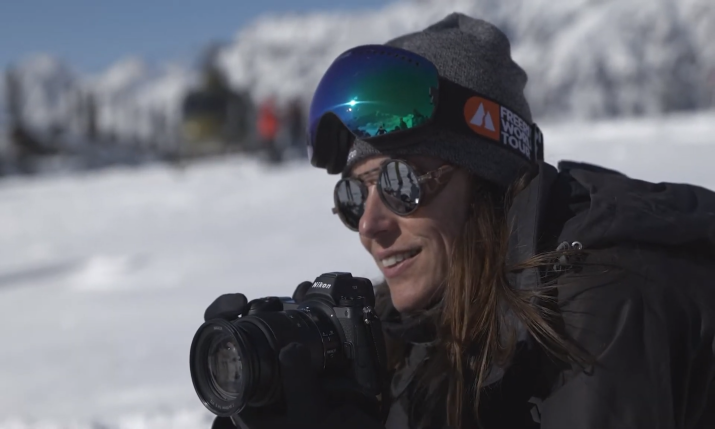
Aurelie Gonin, head of Alpine Medias House and winter sports director
There are not many jobs in the world where you have to be an athlete to even begin your daily tasks, but Aurelie Gonin, director at her own company, Alpine Medias House, is one of those people.
Gonin is a winter sports specialist. She directs, produces, films and edits, with the vast majority of her work taking place on the snowy slopes of mountain ranges across the world.
Just to get to work, she often has to be dropped out of a helicopter onto the side of a mountain, ski on some of the toughest runs in the world get into position, and set up in freezing conditions before the sun has made an appearance so she is ready for the appearance of the (non-crew) athletes.
Bright, white, reflective world
Most importantly, she needs to understand the intricacies of not only her dangerous environment, but the challenges of filming in a bright, white, reflective, steep world, to capture all the thrills and spills of winter sports.
“I never experienced such an intense and positive mental tension as when I directed a live event. You are carried by the collective energy of all those people collaborating together to put on a great show”
On the specialist aspect of her job, Gonin notes: “Through the years I have acquired an expertise in making any kind of videos in a mountain environment, by collaborating with various people and learning from their experience and from the different situations. I’m often asked to do things that I haven’t done before, and I’m always keen for a new challenge which will push me and maybe open new opportunities.
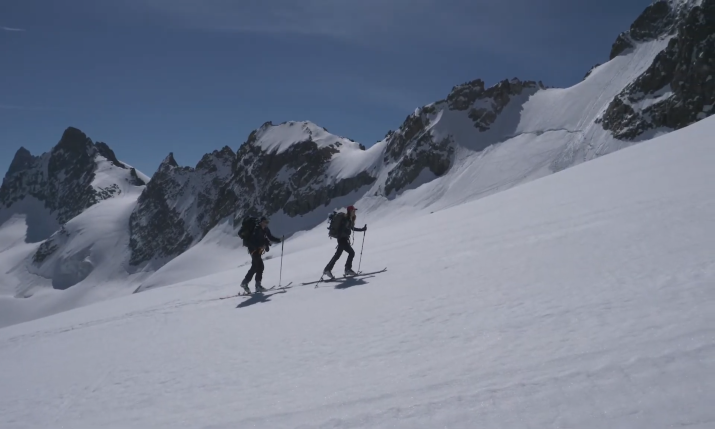
Trekking up mountains to get into position to film is part of the job for Aurelie Gonin [seen here leading]
Positive pressure
As to what excites her about her job, Gonin says: “I love the positive pressure that comes with working so fast, directing live, and being guided by the super dynamic flow which leads the competitions.”
She continues: “There are so many things I enjoy about it! I can mention skiing in the dark to access the position before first light, enjoying a sunrise on top of a mountain, sharing these emotions with fantastic people, being thrilled by the stunning actions happening in front of our cameras… I feel in harmony with the place and with the people. I give a lot of passion and energy, but I get so much back.”
Gonin adds that live directing is the biggest adrenalin rush for her: “I never experienced such an intense and positive mental tension as when I directed a live event. You are carried by the collective energy of all those people collaborating together to put on a great show, you feel the presence of your team behind you, you constantly talk to some of them, and at the same time you’re alone because you’re the only one pressing the buttons to create what spectators will see. The focus is so intense, it’s like having several brains to be able to analyse all that’s happening and take fast decisions, and it lasts four to five hours.
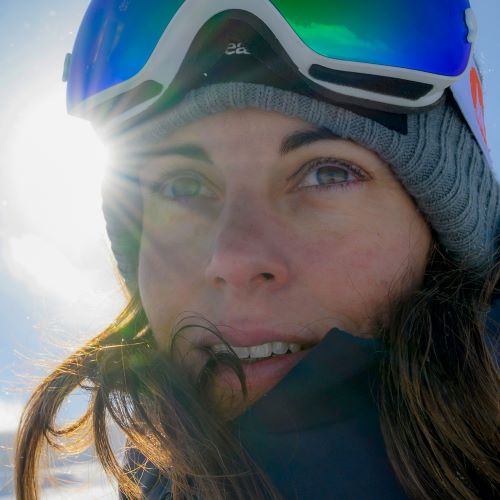
Aurelie Gonin: “I love the positive pressure that comes with working so fast, directing live, and being guided by the super dynamic flow which leads the competitions.”
“I often tell the athletes that when they’re in the start gate ready to drop in and it comes the 5-4-3-2-1 countdown, their pressure is the same as mine when we start the live,” she goes on. “And when live is over I’m exhausted, I gave all my energy to it. I really love that feeling, it makes me feel really alive.”
Extreme freeride challenges
On the toughest events she has worked on, Gonin states that the freeride competitions are the most extreme because the live broadcast has to come from the side of a mountain. She explains the rigours demanded of the crew: “The technical crew sets up a tent on a ridge in front of the venue in which they build all the equipment for the live and link the cameras, which are long lenses, drones, cineflex and more. It’s such a challenge for these guys and I have a big respect for them, (big up to Switch Productions!). You access the tent on skis in the dark to be ready early morning when the competition starts, and then you freeze during all the live action because you’re in the snow. It’s not the comfort of a studio, but the excitement of being on a mountain to show those stunning action sequences to the audience, are the best compensation.”
She comments on Freeride World Tour: “I spent six winters travelling with this crew, shared amazing adventures with them, learning a lot from working in this environment, and creating videos for all kinds of media (live, TV, web, social) in a short amount of time. It wasn’t an easy choice when I decided to quit, but I thought it was time to move on and I don’t regret it because it opened new opportunities to me, including an extraordinary heliskiing event in Pakistan and soon the Olympic Games. I’m convinced that the coolest projects are still to come.”
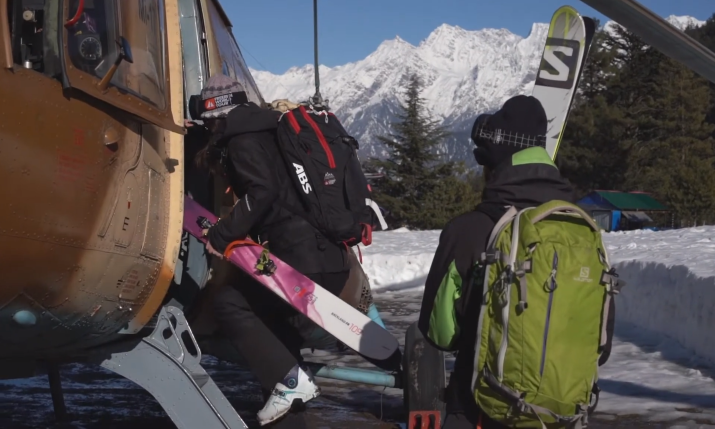
Aurelie Gonin, Alpine Medias House, getting into a helicopter to be dropped on top of a mountain to film a freeride event
Always on the road
Gonin’s daily life has changed drastically since COVID closed down borders. Until March 2020, her main role involved working on international live sporting events. However, everything changed on the 13 March: “That day I was about to start three weeks of freeride events in Switzerland, when everything got cancelled. I had to change a lot of things in my job, and in my life. Because I was always on the road I had no home, so I got a place. I haven’t seen my American boyfriend [American freeskier Seth Morrison] in almost a year because borders were closed, so when we finally found a solution to meet we married, which was the most positive thing from that special year.
“On the professional side, I’ve always done a variety of things and it’s what saved me; when I couldn’t direct a live event I still could write articles, record tutorials, and prepare projects. I managed to start new collaborations and right at the end of the first lockdown I was directing sports and wildlife documentaries for The Explorers network, which was fantastic. I also filmed some corporate videos, and it was very interesting to discover new worlds. In the end I never stopped working and created new opportunities.
“But I was missing sports events a lot, because I like the energy of a big team pushing together to create something unique,” she continues. “Last week I was stoked to work on Nendaz Freeride’s first event, it was like coming back to real life! Soon we’ll do the live webcast of their main competition. I can’t wait to be on the mountain with all the guys and be live to put on the best show we can.”
Today in a COVID-world, working in live sport is challenging because of the uncertainty, Gonin notes. “What is a very difficult year already is that every project is uncertain. Even the Olympic Games have been postponed! You make your best to plan, organise every detail, book your team, but everything can change at the last minute or even be cancelled. At the opposite [end of the scale] you can be called for a project which is created in a few days. It’s quite hard to work like this; you have to be very versatile and not stress too much about not knowing what’s coming. I’m usually very excited when I get a phone call for a new project, and I try to tone down my enthusiasm to be less disappointed if it doesn’t happen. It’s been a difficult year already, and I hope we can trust the future again very soon.”
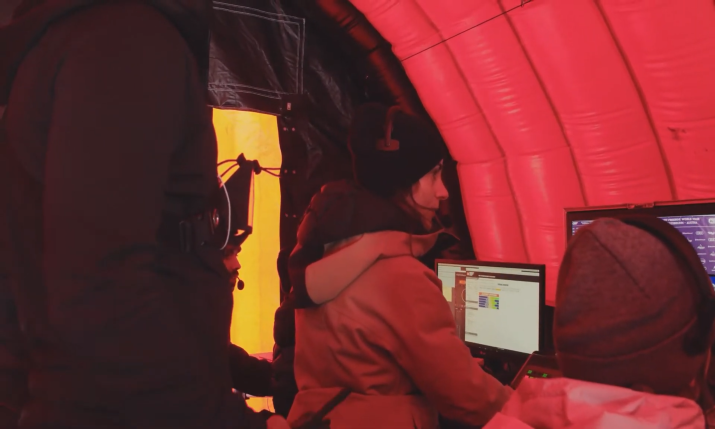
Often setting up before sunrise on the side of a mountain range, Aurelie Gonin often finds herself in a freezing tent for a day’s work
From the beginning
Back to her career progression, Gonin says: “As far as I can remember, I’ve always wanted to work in video production, but didn’t know if it would be fiction [films], journalism or sports; through the years I’ve been working in the three [areas], so now I can say that sports is my first choice and what I prefer to do.”
On the start of her career, Gonin comments: “I grew up in Albertville, which hosted the 1992 Winter Olympic Games, and as a child I was watching the crew of cameramen with admiration, thinking they were super cool people doing an amazing job. Then when I became a teenager I started watching plenty of freeride ski and snowboard movies and loved this alternative culture, which became mine. I work in this environment for years now and I just married one of its heroes, Seth Morrison.”
She studied for five years after graduation in France to achieve a Master of Sciences, Arts and Techniques in Shooting and Editing. She did several internships during this time in various areas of production and started working after her Masters as a camera assistant on fiction films.
On those internships, she comments: “Some of the internships I did during my studies have been at camera gear renter Panavision, where I could learn about this equipment and meet the camera assistants, who ended taking me into their teams. I’m pretty old (41) so when I started working in early 2000, fiction movies were shot on S35mm film. My missions as a camera assistant were to set up the camera, load the film and after a few years, pull the focus.”
However, her time in film was short lived, she explains: “It’s been a fantastic experience to take part on some fiction movie shootings, but the job of a camera assistant is pure technique; there’s no creation or storytelling at all. Maybe it has evolved a bit since then but at this time as a woman I didn’t have much a future, no chance to ever hold the camera, do the framing and even less lighting. There were no female camera operators or DOP in fiction [then].
“The mentality was also very old school and not always respectful for women. I’m not an easily offended person but I had some unappropriated proposals that I never experienced in any other area of production. These reasons made me look in other directions.”
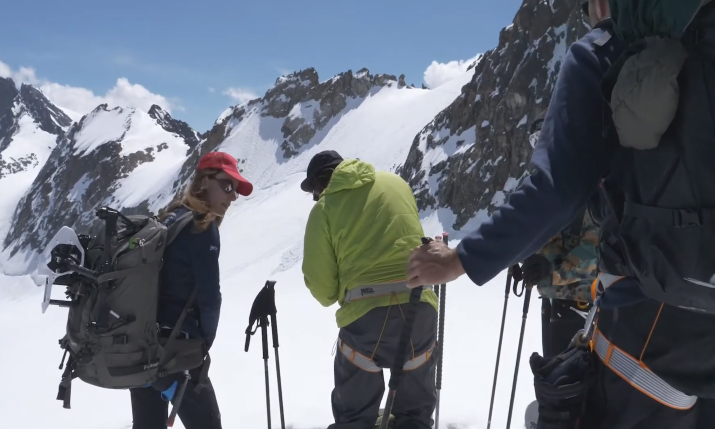
Aurelie Gonin [far left] getting into position with her team
On those career challenges Gonin has faced, she says: “There are not many women in mountain sports video production; I’ve heard of a few in other countries but haven’t met them, so basically I’m the only one in a big team of men. It has never been a problem, I never felt uncomfortable or have suffered any lack of respect like I did in fiction movies. Last winter I worked on a heliskiing event in Pakistan, where I was amazed by the kindness of the people, very far from what our media portrays, and it’s been an incredible experience.
“Because mountains can be dangerous you have to think as a team and not as individuals. You have to take care of each other, and maybe it’s part of why nobody cares if I’m a man or a woman. It has never been an obstacle my career evolution either.”
“I think now more than ever we have to be versatile and agile, able to change our workflows and our storytelling. We’re in constant evolution, which is very exciting”
After becoming disillusioned with film, Gonin moved into the education sector, where she worked as a technical director and trainer at the Sciences Po school of journalism in Paris, “where I learned a lot about storytelling and business, which have both been very useful”. She adds: “I’m still a trainer now, certified in Adobe and Apple, and do masterclasses for companies and universities. On my last day at this school, I had the chance to attend a speech by Aung San Suu Kyi who said, “Life is about growing”, and I tried to follow her advice since then.”
In 2012 she quit Paris and moved back to the Alps, where she gathered all her past experiences into her passion: mountain sports video production.
A few months later she was hired as an editor for the Red Bull Elements event, where she met the producer David Arnaud with whom she has collaborated over the years. She continues: “I joined the team of Freeride World Tour, the main freeride skiing and snowboarding competition, first to improve the production workflow and then to become editor-in-chief, slow-mo operator, and finally live director and head of video production.
“It’s been amazing years of travelling through the world with the best team. I learned a lot from these experiences, but it was also so time consuming that I had to say no to any other project, which was frustrating. Last year I decided to stop, because I had the opportunity to become a member of OBS team for the Winter Youth Olympic Games and then in Tokyo.”
Right now Gonin is working on several jobs through her company, Alpine Medias House, and as a member of the Krew Collective [creative freelancers for hire]. I can be a simple camera operator or editor, but most of the times I’m directing the videos or live sport.” She adds: “Through the years I built a network of people in various areas who hire me for a project of recommend me to other people, and that’s how it grows and evolves. I take any opportunity to get out of my comfort zone, because I’m very motivated by new challenges and they’re what makes me grow.”
Yet with success comes a lack of time to spend on her own projects, say Gonin. “What is very hard for me at this point of my career is that despite [the fact that] I always have a lot of pleasure directing videos for my partners, I’d really love to create mine. I have a few stories I’d like to tell, but because it’s not my job to find funding I don’t manage to [kick off] these projects, which is very frustrating. This is the hardest thing now; and I don’t find it hard to be cold, exhausted, hungry or uncomfortable from a shooting on a mountain!”
Stay versatile and agile
As to advice Gonin would give to other women looking to move into a role in sports broadcasting like her own, she says: “Sports evolve, the way audience watch them evolves even faster, and video has to follow (or lead?) these evolutions. I think now more than ever we have to be versatile and agile, able to change our workflows and our storytelling. We’re in constant evolution, which is very exciting.
“I’d say ‘be the best in what you’re doing’ and nobody will care if you’re a man or a woman; they’ll want to work with you for what you are. We’re in 2021 and I don’t see any limit for a woman in sports broadcasting, so there’s no reason to be shy. It’s a fantastic environment with amazing people,” she enthuses.
Aurelie Gonin recently took part in the SVG Europe Winter Sports Summit – watch her segment here
